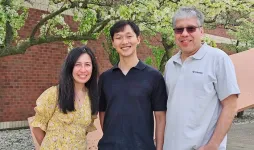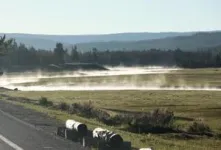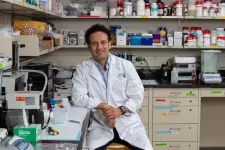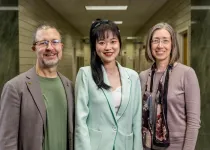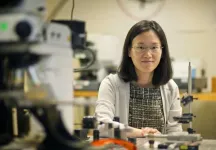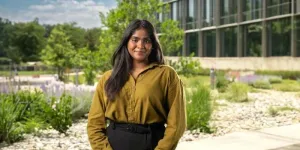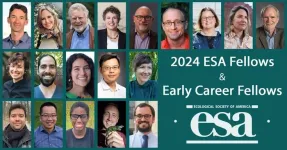(Press-News.org) URBANA, Ill. – When scientists look at the Earth’s available water for ecosystem services, they don’t just look at precipitation. They must also account for water moving from the ground to the atmosphere, a process known as evapotranspiration (ET). ET includes evaporation from soil and open water pools such as lakes, rivers, and ponds, as well as transpiration from plant leaves. The difference between precipitation and ET indicates the water balance available for societal needs, including agricultural and industrial production. However, measuring ET is challenging. A new study from the University of Illinois Urbana-Champaign presents a computer model that uses artificial intelligence (AI) for ET prediction based on remote sensing estimates.
“Ground-based ET estimates capture the local fluxes of water transferred to the atmosphere but are limited in scale. In contrast, satellite data provide ET information on a global scale. Still, they are often incomplete due to clouds or sensor malfunction, and the satellite cycle over an area may require several days. We conducted this research to predict missing data and to generate daily continuous ET data that accounts for the dynamics of land use and atmospheric air movement,” said lead author Jeongho Han, a doctoral student in the Department of Agricultural and Biological Engineering (ABE), part of the College of Agricultural, Consumer and Environmental Sciences and The Grainger College of Engineering at Illinois.
The researchers created the “Dynamic Land Cover Evapotranspiration Model Algorithm” (DyLEMa) based on decision-tree machine learning models. This algorithm is intended to predict missing spatial and temporal ET data using trained seasonal machine learning models. DyLEMa was evaluated to the scale of Illinois on a daily 30 x 30-meter grid for 20 years using data from NASA, the U.S. Geological Survey, and the National Oceanic and Atmospheric Administration.
“DyLEMa is much more detailed and complex than other models. It distinguishes between different land uses, including forest, urban, and agriculture, and different crops, such as corn and soybean. The model includes precipitation, temperature, humidity, solar radiation, vegetation stage, and soil properties. This allows us to capture the surface dynamics accurately and predict ET based on multiple variables. This is especially important for agricultural landscapes where crops change rapidly,” said co-author Jorge Guzman, research assistant professor in ABE.
The researchers tested the model’s accuracy by comparing its results with existing data. For validation over time, they used ground measurements from 2009 to 2016 at four sites in Illinois. Also, to test spatial accuracy, they created artificial scenarios where they inserted a synthetic cloud in a cloud-free image, then applied their algorithm and compared the results with the original data. Overall, DyLEMa reduced ET prediction uncertainty in cumulated ET estimates from an average of +30% (overpredicted) to around -7% (underpredicted) compared to existing measurements, indicating much greater accuracy.
The study is part of a larger project on soil erosion funded by the USDA National Institute of Food and Agriculture. Maria Chu, an associate professor in ABE, is the principal investigator on that project and co-author of the new paper.
“ET controls the soil moisture content and vice versa, which impacts surface processes such as runoff and erosion. Our next step is to integrate our data in a distributed hydrological model for better estimation of soil erosion,” Chu said.
“One of the challenges with land management practices is that people may not see the benefit of implementing changes right away. But with this model, we can show that what you are doing now will have a long-term impact, for instance, 10 or 20 years from now and at locations far from your farm. This is the power of using data and computing capacity for engaging communities and informing policy measures,” Chu added.
The researchers worked with the National Center for Supercomputing Applications (NCSA) and the Illinois Campus Cluster Program (ICCP) to process data and train models. They plan to make their data, including output for 20 years in Illinois, available for other researchers.
The paper, “Dynamic land cover evapotranspiration model algorithm: DyLEMa,” is published in Computers and Electronics in Agriculture [doi.org/10.1016/j.compag.2024.108875]. The US Department of Agriculture - National Institute for Food and Agriculture (NIFA) award number 2019-67019-29884, the ACCESS program funded by the National Science Foundation, and the UIUC Illinois Campus Cluster provided funding for this research.
END
Illinois researchers develop an AI model to reduce uncertainty in evapotranspiration prediction
2024-04-30
ELSE PRESS RELEASES FROM THIS DATE:
Is it time to retire the best-before date?
2024-04-30
The inventors of a suite of tests that enable food packages to signal if their contents are contaminated are working to bring producers and regulators together to get their inventions into commercial products, with the goal of preventing illness and reducing food waste.
Though the tests would cost just a few cents per package, food producers are reluctant to add costs that consumers will ultimately have to bear, say the McMaster researchers behind an article published today in the journal Nature Reviews Bioengineering.
A system based on smart packaging, the researchers say, would save producers ...
An electrifying discovery may help doctors deliver more effective gene therapies
2024-04-30
MADISON — In an effort to improve delivery of costly medical treatments, a team of researchers in electrical engineering at the University of Wisconsin–Madison has developed a stimulating method that could make the human body more receptive to certain gene therapies.
The researchers exposed liver cells to short electric pulses — and those gentle zaps caused the liver cells to take in more than 40 times the amount of gene therapy material compared to cells that were not exposed to pulsed electric fields. The method could help reduce the dosage needed for these treatments, making them much safer and more affordable. The research appears April 30 in the ...
Lurie Children’s Hospital first-in-pediatrics to use technology that lights up lung cancer during surgery
2024-04-30
Ann & Robert H. Lurie Children’s Hospital of Chicago is pleased to announce the first pediatric use of the novel fluorescent agent CYTALUX during surgery to remove lung metastases. The drug allows surgeons to better visualize cancer in the lung, as well as potentially detect additional cancerous nodules missed by preoperative imaging. This drug is FDA-approved in adult patients, but Lurie Children’s is the first-in-pediatrics to have an Investigational New Drug application with the FDA to study ...
$3.6 million to advance nuclear energy awarded to U-M
2024-04-30
Four U-M projects funded by the Department of Energy's Nuclear Energy University Partnerships program aim to make nuclear energy safer and more equitable.
The projects are designed to improve the monitoring of nuclear reactors during operation; explore the safety of an advanced modular reactor design; develop a framework for ethical, consent-based siting of nuclear facilities; and upgrade a facility for modeling radiation damage to reactor components.
Real-time radiation effects on optics
How well could optical sensors monitor future advanced nuclear reactors? Funded with $1 million, Igor Jovanovic, a professor of nuclear ...
Two UT Arlington faculty honored for outstanding research
2024-04-30
The University of Texas at Arlington is honoring two faculty for their outstanding contributions to research.
Yuze (Alice) Sun, associate professor of electrical engineering, and Venu Varanasi, associate professor in the Bone Muscle Research Center, are the 2024 recipients of the University Award for Outstanding Research Achievement or Creative Accomplishment. This award recognizes faculty members for achieving significant research or creative accomplishments during the past three years.
“Alice and Venu are truly bright stars on the faculty at UT Arlington,” ...
UT Arlington student links worm behavior to brain disease
2024-04-30
As an undergraduate student in The University of Texas at Arlington’s Honors College, Hannah Selvarathinam knew she wanted to conduct research. Near the end of her first year at UTA, the Keller native reached out to the lab of biology Assistant Professor Piya Ghose.
“Hannah has been a very impressive scholar from Day 1,” Ghose said. “She had the foresight to reach out for research opportunities very early on.”
Ghose brought Selvarathinam in to work on one of the lab’s core projects ...
Uncovering the secret of long-lived stem cells
2024-04-30
Nothing lives forever, but compared to other cells in the body, hematopoietic stem cells (HSCs) are remarkably long-lived. HSCs are blood-forming cells – they give rise to rapidly dividing progenitor cells, which in turn generate hundreds of billions of cells to fulfill the daily demand of oxygen-delivering red blood cells, disease-fighting white blood cells and clot-forming platelets.
HSCs typically remain dormant within the bone marrow, yet they possess the ability to activate and replenish blood cells continuously, maintaining a relatively youthful profile throughout the life of an organism. What is the secret of ...
The question for online educational platforms: offer courses following a schedule or release them on demand?
2024-04-30
Researchers from Carnegie Mellon University and University of Pennsylvania published a new Journal of Marketing study that examines online educational platforms and the question of whether they should release content through a scheduled format that resembles a traditional university course or use an on-demand release strategy.
The study, forthcoming in Journal of Marketing, is titled “More Likely to Pay but Less Engaged: The Effects of Switching Online Courses from Scheduled to On-Demand Release on User Behavior” and ...
Study: racial bias is no 'false alarm' in policing
2024-04-30
Black drivers are more frequently searched during traffic stops without finding contraband than white drivers, according to a University of Michigan study.
Institute for Social Research scientists Maggie Meyer and Richard Gonzalez analyzed data from 98 million traffic stops, and showed that innocent Black drivers were likely to be searched about 3.4 to 4.5 percent of the time while innocent white drivers were likely to be searched about 1.9 to 2.7 percent of the time. Their results are published in the Journal of Quantitative Criminology.
"We show that there's ...
Ecological Society of America announces 2024 Fellows
2024-04-30
The Ecological Society of America is pleased to announce its 2024 Fellows. The Society’s fellowship program recognizes the many ways in which its members contribute to ecological research, communication, education, management and policy. This year, the ESA Governing Board has confirmed nine new Fellows and ten new Early Career Fellows.
Fellows are members who have made outstanding contributions to a wide range of fields served by ESA, including, but not restricted to, those that advance or apply ecological knowledge in academics, ...
